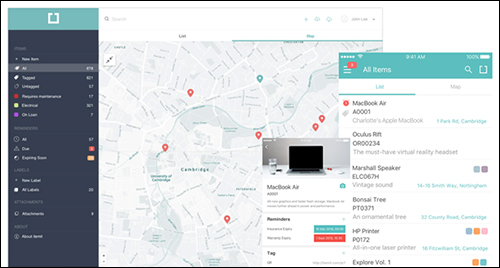Although the cost of tags, readers and software has been dropping in recent years, RFID deployments are still unaffordable for many companies seeking item-level inventory tracking. Cambridge U.K.-based Internet of Things software company RedBite (a spinoff of the Auto ID Labs) has developed a low-cost solution known as itemit, consisting of iOS- and Android-based apps and an enterprise Web portal.
“Until now, RFID has still been a very exclusive technology,” says Alex C.Y. Wong, RedBite’s CEO, with software installations that are too cost-prohibitive for many companies. In the case of itemit, on the other hand, if a single user employs QR codes to identify and track items, the service is free. If the user wants to share asset data with others within his or her company, the firm would pay a monthly subscription upgrade for itemit Enterprise for each user. If the system employs ultrahigh-frequency (UHF) RFID, it costs approximately $200 a year per user, with an additional charge to share the data with other individuals.
The itemit app has been available for the past six months for use with QR codes. This month, RedBite launched its RFID version for iOS devices, and the technology is expected to be available for Android devices as well by next month.
The app is designed for simplicity, the company reports. Users can download it to their smartphones or tablets, then begin setting up profiles of assets—taking pictures, adding attachments, setting expiration dates or other alerts, and inputting any comments about each item on that item’s page. In the case of QR codes, they then scan the QR code to link it to that item.
With regard to RFID use, individuals or businesses would need to acquire the RFID-enabled functionality in the app. They can use the app on their phone if it is paired with a Bluetooth-based Technology Solutions (UK) Ltd. RFID-enabled reader—or, by August, Zebra Technologies‘ RFD8500 sled reader.
Users purchase RFID tags—any standard EPC UHF RFID tag will work with the system, Wong says. The tags can be applied to anything from industrial equipment to buildings’ health and safety assets, he explains, but most commonly will be applied to high-value moving assets. When a user sets up a profile for an item, such as a laptop, he or she can take photos and upload documents such as a user’s manual or inspection report. The user can then add customizable information—for example, the department that owns the item, the asset’s status, and such descriptors as color or make and model—in order to differentiate it. The app stores this data along with the RFID tag ID and the item’s location on its profile page.
If a user wants to share data, the app can capture who reads the tag and when this occurs, and display where the items are located on a Google Maps display. If an individual is only seeking laptops or a specific type of laptop, he or she can filter the view to just view those items on the map.
Additionally, the app will send iOS or Android notifications to users if alerts have been set up. For example, it can indicate that a specific item is due for inspection or is about to expire.
Several companies are currently using the technology, including Action Dry Emergency Services, a U.K.-based flood damage response firm. The company is using itemit to track its equipment around the United Kingdom.
In the meantime, Cambridge University’s Institute for Manufacturing is utilizing the system to manage its assets, and is starting to use RFID to track the locations of high-value assets. Itemit enables the Institute to use the itemit app to view where each asset was last located, by whom, and when it was inspected or maintained.
Wong says the Institute is beginning to use RFID for some assets that are difficult to reach. Users will be able to simply wave the RFID reader within a few meters of a tagged asset in order to view the data they seek, as well as update any information about that item. The last-seen date and location will be automatically updated each time the tag is scanned, thereby speeding up inspection and maintenance.
“We think itemit is the kind of technology customers have been waiting for,” Wong states. While using RFID to track goods seemed like a technology only for larger companies, he adds, it will now be affordable for most businesses that want to track assets. “Until now, RFID asset tracking solutions were reserved for large, wealthy organizations. Thanks to itemit, an instant-signup, low-cost asset-management solution with RFID is affordable and attainable for even the smallest of organizations.”



